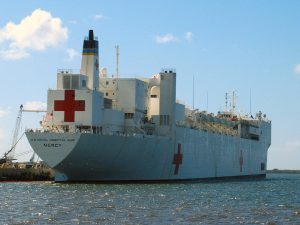By: Rose Lyu

The Second Geneva Convention protects wounded, sick and shipwrecked military personnel at sea during war.
Since their adoption in 1949, the Geneva Conventions, which contain the most important rules limiting the barbarity of war, have been employed and applied broadly. The Conventions have been subjected to the rapidly changing environment of the international community, yet the Second Geneva Convention has remained unchanged since its adoption. International instruments regulating activities at sea have developed significantly since 1949, in particular the United Nations Convention on the Law of the Sea and several other conventions under the auspices of International Maritime Organization. At the same time, global military capabilities have evolved dramatically in the naval domain, including in improved precision of long-range strike capabilities and autonomous underwater vehicles remotely operated at great distances. These developments in technology have outpaced the legal framework of the international community, leaving potentially hazardous uncertainty that may increase the possibility of maritime conflicts, especially in the contested areas such as the South China Sea.
During the past several decades, naval space has become more important for sovereign States with tremendous development of naval capacities. The International Committee of the Red Cross (ICRC) has also relied on naval space to carry out its humanitarian activities, such as chartering vessels to evacuate the wounded and sick, bringing in relief supplies to areas inaccessible by land and facilitating the return to home of detainees, etc. In order to adapt to the increasingly complex nature of current warfare and to meet the growing challenges posed by armed conflicts, the ICRC is exploring how feasible it would be to have its own hospital vessel. The vessel will strengthen the ICRC’s ability to respond to emergency hospital rescues, and will improve its role better under the current international climate.
As maritime security issues continue to catch frequent headlines, which has drawn an increased attention from governments, the need to properly apply humanitarian law, which is specifically and exclusively designed to provide shelter in the context of international armed conflicts, becomes even more urgent and significant. The ICRC activities is an example of humanitarian law operations, which can occur in various forms.
The Second Geneva Convention requires the Parties to the conflict to take all “possible measures” to search for, collect and provide care to the victims of an engagement at sea, which makes it crucial to ensure that care and protection are provided with each engagement. The ICRC has an important role as the guardian and promoter of international instruments regarding humanitarian rule of law, as it is an impartial, neutral and independent organization whose exclusive humanitarian mission is to respect and protect lives and dignity of victims of the armed conflict and other situations of violence.
Under current circumstances, by taking these legal and factual developments into consideration, with the purpose to function more efficiently and to yield more positive contribution through its activities, the ICRC launched an updated version of its commentary on the Second Geneva Convention of 1949 May 2017, which aims to protect the wounded, sick, shipwrecked of the armed forces at sea, as well as certain other persons and objects, including medical personnel and hospital ships. This updated Commentary follows the ICRC’s mission and mandate and will facilitate common interpretation of the meaning and critical importance of the provisions of the Second Geneva Convention, which in turn will improve the protection of those who suffer during armed conflict at sea.
